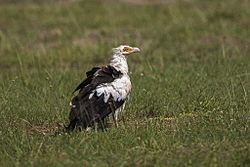Palm-nut vulture facts for kids
Quick facts for kids Palm-nut vulture |
|
|---|---|
 |
|
| Conservation status | |
| Scientific classification | |
| Kingdom: | |
| Class: | |
| Order: | |
| Family: | |
| Genus: |
Gypohierax
|
| Binomial name | |
| Gypohierax angolensis (Gmelin, 1788)
|
|
The palm-nut vulture (Gypohierax angolensis) is a special type of bird that lives across most of Africa. Unlike most vultures, it mainly eats the fruit from oil palm trees. These birds are quite friendly and can often be seen close to where people live.
Contents
What They Look Like
Adult palm-nut vultures are easy to spot. They are the smallest Old World vultures. They weigh about 1.3 to 1.7 kilograms (around 3 to 3.7 pounds). They are about 60 centimeters (24 inches) long and have a wingspan of 150 centimeters (59 inches).
Their feathers are mostly white. They have black areas on their wings and tail. They also have a bright red patch around each eye. Young palm-nut vultures look different. They are brown with yellow patches around their eyes. It takes them about 3 to 4 years to grow into their adult feathers.
When flying, this bird looks more like an eagle than a typical vulture. It can flap its wings for a long time. This means it does not always need warm air currents (thermals) to stay in the sky. An adult palm-nut vulture might be confused with the African fish eagle or the Egyptian vulture. However, it does not have the reddish-brown body of the fish eagle. It also lacks the white tail of the Egyptian vulture.
Male and female palm-nut vultures look almost the same. Females are only a little bit bigger than males. Young birds are mostly brown. Their wings are partly black. It takes them a long time, three to four years, to get their adult white and black feathers.
Where They Live
Palm-nut vultures live in many coastal parts of Africa. You can find them from The Gambia all the way to Kenya. They also live as far south as South Africa. Experts believe there are about 80,000 pairs of these birds in Africa. In South Africa, there are about 40 individual birds.
Their Home Environment
As their name suggests, palm-nut vultures usually live where oil palms (Elaeis species) or raffia palms (Raphia species) grow. This means they are most common in forests near the coast. They also live in mangrove swamps below 1,500 meters (about 4,900 feet). Sometimes, they can be found in wet savannas too.
What They Eat
Palm-nut vultures have a very unusual diet for a bird of prey. They mostly eat the fleshy fruit husks of the oil-palm and the fruits of the raphia palm (Raphia australis). These fruits make up more than 60% of an adult bird's diet. For young birds, these fruits are over 90% of what they eat.
They also eat other things. These include crabs (from both fresh and salt water), snails and clams, frogs, fish, and locusts. They might also eat small mammals, and even reptile eggs and baby reptiles. Sometimes, they have been seen eating farm birds or animals that have died.
Nesting and Reproduction
Breeding pairs of palm-nut vultures build large nests out of sticks. They place these nests high up in tall trees. They often stay very attached to their nesting spot. They might even stay there for a whole year. If raffia palms are around, they will build their nest at the base of the palm fronds.
At the start of the breeding season, pairs fly together. They perform amazing aerial displays. They roll and dive in the air, which is much more acrobatic than most vultures. During each breeding cycle, the female lays just one egg. The egg is white with brown markings. Both the male and female take turns sitting on the egg. This incubation period lasts for about four to six weeks. The young chicks are brown when they hatch. They usually learn to fly about 85 to 90 days later.
Palm-nut Vultures in South Africa
South Africa and Mozambique are the only places in Southern Africa where palm-nut vultures breed regularly. In the 1970s, most breeding palm-nut vultures were found around the raffia palm groves of Kosi Bay and Mtunzini. Their presence is strongly linked to where raffia palms (Raphia australis) grow. For example, the birds in Mtunzini are there only because raffia palms were planted by people. Currently, there are 7 known nesting sites in South Africa. There are a total of about 40 individual birds.
Images for kids
-
Semliki Wildlife Reserve, Uganda
-
Kazinga Channel, Uganda
-
Immature bird in Selous Game Reserve, Tanzania
See also
 In Spanish: Buitre palmero para niños
In Spanish: Buitre palmero para niños







